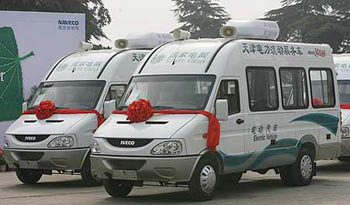 |
|
NAVECO's electric-powered Daily was pressed
into service in a pilot programme on March
10th this year after more than a year's
worth of Research & Development, in the
process becoming China's first production
electric commercial vehicles. |
|
|
|
NAVECO'S (Nanjing Auto Iveco) zero-emission
electric Daily light bus has received a
significant sales boost as China's Ministry of
Industry and Information Technology (MIIT) has
placed it on a list of just five vehicles that
will be liable for state purchasing subsidies.
Developed and built by NAVECO, a joint venture
between Iveco and now Shanghai Automotive
Industry Corporation (SAIC), which took over
Nanjing Auto, the electric Daily was China's
first production electric commercial vehicle.
At the start of
the year the Chinese finance ministry revealed ambitious
plans to offer generous cash subsidies for consumers
purchasing new very low environmental impact vehicles. To be
approved the vehicle has to be tested for energy saving
abilities and be capable of mass production, by the MIIT,
with its components also checked for quality and volume
production capability. The subsidy is on offer is up to
50,000 yuan for a hybrid vehicle and 60,000 yuan for an
electric vehicle. The subsidies are part of the Chinese
authorities plans to take a global lead in developing
efficient technology as well as a practical means of
tackling pollution in its own cities.
NAVECO's
electric-powered Daily was pressed into service in a pilot
programme on March 10th this year after more than a year's
worth of Research & Development, in the process becoming
China's first production electric commercial vehicles. The
State Grid Corporation of China (SGCC)
is now using 10 of these vehicles to transport its staff and
equipment. The Daily light bus is visually identical to the
normal production model but the diesel engine and associated
drivetrain have been replaced by a zero-emission and
pollution-free electric motor and transmission. The Daily
electric light bus also surpasses its class rivals in terms
of efficiency as it uses 40 kWh of electricity for every 100
kilometres which equates to five litres of diesel fuel from
an internal combustion engine and it has a very useful range
of 220 kilometres meaning that it is a practical proposition
for business operators. The electric supply is also able to
power internal remote equipment which is allowing the SGCC
to have mobile office features in the fleet.
As well as
NAVECO'S electric Daily bus the other four vehicles on the
MIIT shortlist to be available for subsidies are Jianghuai
Auto's all-electric engineering vehicle, Zoyte Auto's
electric minibus and BYD's F3DM plug-in hybrid sedan which
was presented at the Geneva Motor Show last year and which
went on sale in China last December but only to bulk buyers.
The F3DM is the world's first hybrid mass-production compact
sedan and is expected to be launched in Europe next year.
Meanwhile Fiat
Group is currently negotiating with SAIC to give up the
unusual 51-49 percent split in the NAVECO venture, China's
light commercial vehicle market leader, in favour of a more
normal, for China, 50-50 partnership. Fiat has been
reluctant to give up its controlling stake despite the
unresolved ownership issue holding back the progress of the
venture. SAIC will absorb its own commercial platforms and
related divisions into NAVECO once the deal has been
renegotiated which is expected to be completed next month.
|